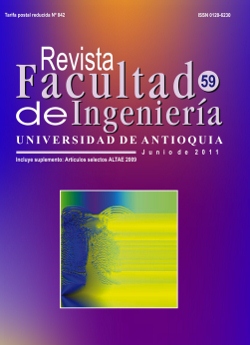Vendor Managed Inventory (VMI) in micro, small and medium enterprises (MSMEs) – Plantain agricultural-chain
DOI:
https://doi.org/10.17533/udea.redin.13823Keywords:
supply chain integration, logistics cost, coordination, plantain agro-chain, vendor managed inventoryAbstract
This paper emerges as a research result of the Vendor Managed Inventory (VMI) issue to a dehydrated plantain productive chain, which is composed by a dehydrating plant (supplier) and a pig-raise farm (client), adding the product transport cost as an integral parameter to inventory cost, in order to examine the inventory process practice before and after establishing VMI. Initially a chain contextualization in the field sector and the Colombian plantain agro-industry is shown. Then, the inventory coordination model is formulated taking as reference the model proposed by Yao, et al. [1], which is based on the model of economic batch supplier order. According to the previous information, the mathematical model is then applied with VMI and without VMI, after that, the product transport cost is incorporated to the total cost of management inventory. The result shows that VMI adoption generates savings for the integrated chain and how the transport cost becomes a relevant individual element in the structure for logistics cost of the analyzed chain.
Downloads
References
Y. Yao, P. Evers, M. Dresner. “Supply chain integration in vendor-managed inventory”. Decision Support Systems. Vol. 43. 2007. pp. 663-674. DOI: https://doi.org/10.1016/j.dss.2005.05.021
D. Lambert, M. Cooper. “Issues in supply chain management”. Industrial Marketing Management. Vol. 29. 2000. pp. 65-83. DOI: https://doi.org/10.1016/S0019-8501(99)00113-3
C. J. Vidal. Fundamentos de gestión de inventarios. 3ª ed. Ed. Universidad del Valle - Facultad de Ingeniería. Cali. 2005. pp. 10-35.
R. Feenstra. Integration of trade and disintegration of production in the global economy. Journal of economic perspectives. Vol. 12. 1998. pp. 31-50. DOI: https://doi.org/10.1257/jep.12.4.31
R. Baldwin, M. Philippe. Two waves of globalization: Superficial similarities, fundamentals differences. Working paper No. 690. Cambridge (MA). Oficina Nacional de Investigaciones Económicas (NBER). 1999. pp. 15-69. DOI: https://doi.org/10.3386/w6904
H. Maeersman, E. Van de Voorde. International logistics: A continuous search for competitiveness. A. M. Brewer (editor). Handbook of Logistics and Supply Chain Management. Ed. Pergamon. Oxford. 2001. pp. 61-77. DOI: https://doi.org/10.1108/9780080435930-005
R. Feenstra, H. Gordon. Global production sharing and rising inequality: A survey of trade and wages. Working paper No. 8372. Cambridge (MA). Oficina Nacional de Investigaciones Económicas (NBER). 2001. http://www.nber.org/papers/w8372 Consultada el 19 de octubre de 2010. DOI: https://doi.org/10.3386/w8372
A. Gallardo. “Innovación tecnológica y nuevas formas de organización”. Conferencia dictada por Mariella Berra, investigadora de la Universida de Turín Italia. Editada en Gestión y Estrategia. Edición Internet. 1996. Página web: http://www.azc.uam.mx/publicaciones/gestion/num9/doc8.htm. Consultada el 19 de octubre de 2010.
H. Akkermans, P. Bogerd, B. Vos. “Virtuous and Vicious Cycles on the Road Towards International Supply Chain Management”. International Journal Operations & Productions Management. Vol. 19. 1999. pp. 565-581. DOI: https://doi.org/10.1108/01443579910260883
Y. Dong, K. Xu, M. Dresner. “Environmental determinants of VMI adoption: An exploratory analysis”. Transportation Research Part E: Logistics and Transportation Review. Vol. 43. 2007. pp. 355- 369. DOI: https://doi.org/10.1016/j.tre.2006.01.004
M. Arango, W. Adarme, J. Zapata. “Gestión cadena de abastecimiento - logística con indicadores bajo incertidumbre, caso aplicado sector panificador Palmira”. Revista Neogranadina. Vol. 20-1. 2010. pp. 97-116. DOI: https://doi.org/10.18359/rcin.1480
M. Arango, W. Adarme, J. Zapata. “Commodities distribution using alternative types of transport. a study in the colombian bread”. DYNA. Vol. 163. 2010. pp. 222-233.
Y. Dong, K. Xu. “A supply chain model of vendor managed inventory”. Transportation Research Part E: Logistics and Transportation Review. Vol. 38. 2002. pp. 75-95. DOI: https://doi.org/10.1016/S1366-5545(01)00014-X
S. Disney, D. Towill. “The effect of vendor managed inventory (VMI) dynamics on the Bullwhip Effect in supply chains”. International Journal of Production Economics. Vol. 85. 2003. pp. 199-215. DOI: https://doi.org/10.1016/S0925-5273(03)00110-5
M. Waller, M. Johnson, T. Davis. “Vendor managed inventory in the retail supply chain”. Journal of business logistics. Vol. 20. 1999. pp. 183-203.
Departamento Administrativo Nacional de Estadística – DANE. Encuesta Anual Manufacturera – EAM 2005. Variables principales de la industria según escala de personal ocupado. http://www.dane.gov.co. Consultada el 19 de octubre de 2010.
Departamento Nacional de Planeación. Agenda Interna para la productividad y la competitividad. Resultados del proceso y propuestas iniciales. Bogotá D. C. 2005. pp. 20-46.
Observatorio de Agrocadenas de Colombia. Ministerio de Agricultura y Desarrollo Rural. La cadena de plátano en Colombia. Una mirada global de su estructura y dinámica 1991-2005. Documento de Trabajo N.° 102. Bogotá, D.C. 2005. pp. 1-65.
Downloads
Published
How to Cite
Issue
Section
License
Copyright (c) 2018 Revista Facultad de Ingeniería

This work is licensed under a Creative Commons Attribution-NonCommercial-ShareAlike 4.0 International License.
Revista Facultad de Ingeniería, Universidad de Antioquia is licensed under the Creative Commons Attribution BY-NC-SA 4.0 license. https://creativecommons.org/licenses/by-nc-sa/4.0/deed.en
You are free to:
Share — copy and redistribute the material in any medium or format
Adapt — remix, transform, and build upon the material
Under the following terms:
Attribution — You must give appropriate credit, provide a link to the license, and indicate if changes were made. You may do so in any reasonable manner, but not in any way that suggests the licensor endorses you or your use.
NonCommercial — You may not use the material for commercial purposes.
ShareAlike — If you remix, transform, or build upon the material, you must distribute your contributions under the same license as the original.
The material published in the journal can be distributed, copied and exhibited by third parties if the respective credits are given to the journal. No commercial benefit can be obtained and derivative works must be under the same license terms as the original work.










 Twitter
Twitter